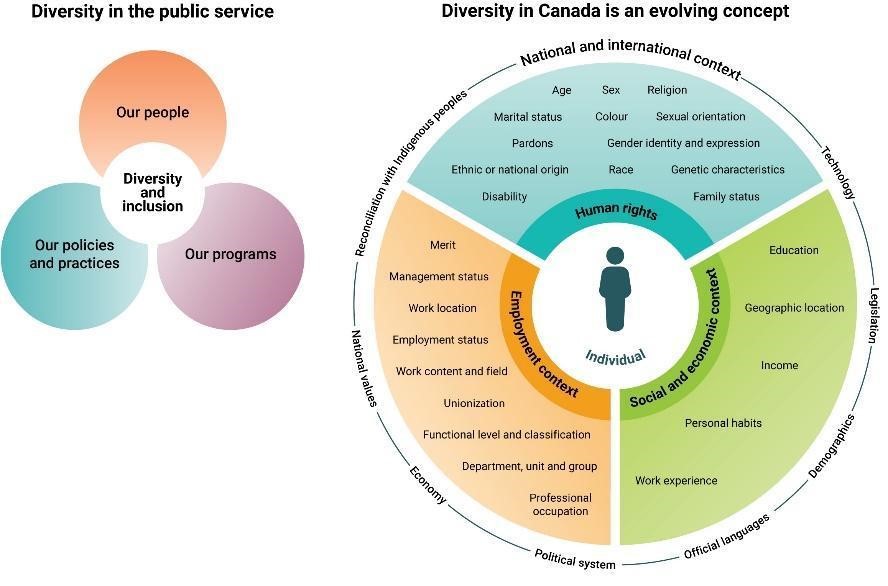5.2 Best practices to build a culture of inclusion
There are many different ways to build a culture of inclusion on your governance board. Each board is different and you will need to develop the specific practice that works for you. Here are some best practices for you to consider as you continue your important work.
1. Develop a clear purpose statement for the board
Your board’s commitment to diversity and inclusion could be incorporated into your mission statement or could be graphically represented to show what your inclusive culture looks like.

The two images are a good example of how to visually represent a commitment to diversity and inclusion. They are based on the results of a diversity and inclusion survey done by Treasury Board of Canada Secretariat, and represent their definition of diversity and their commitment to diversity and inclusion[1]. For an example of an Inclusion and Diversity Statement, review Appendix 7.
2. Cultivate a community of learning
When people share their perspective, they often fail to share the facts or experiences that inform their thinking. Begin by inviting the other person to share their perspective first, by saying something like, “I’d really like to hear your view on this.” Wait for them to respond and be patient, rather than rushing to share your view. You will have an opportunity to talk, but by taking a step back and allowing the other person to speak first, you enhance the potential for learning. [2]
3. Create an intentional dialogue
Creating an ongoing dialogue about how to build a culture of inclusion is a good way to ensure that progress continues[3]. Everyone on the governance board needs to take ownership of the discussion about diversity, equity and inclusion[4].
4. Acknowledge and challenge the biases
We all have biases. It is important to acknowledge them so that we can learn how to minimize them, and can support each other in breaking them[5].
In her 8.5 minute TED Talk called Are you Biased? I Am, Kristen Pressner addresses unconscious bias. She encourages us to recognize the ‘shortcuts’ that happen in our minds and shares a free and fast approach to test ourselves for unconscious bias.
Canadian educator Shakil Choudhury is a consultant in the field of diversity, equity and inclusion. He talks about unconscious bias with Steve Paikin of TVO’s The Agenda in a 25-minute interview called Diversity: Not so black and white.
5. Embrace the differences
Although it is comfortable to do things the same way, with the same people, the way you have always done them, there is tremendous value in difference. As you continue in this process, remind your board members of the positive impact that diversity and inclusion have had on the important work of the board[6].
- Treasury Board of Canada Secretariat (2017). Building a Diverse and Inclusive Public Service: Final Report of the Joint Union/Management Task Force on Diversity and Inclusion. Retrieved from Government of Canada ↵
- Stoker, J. (May 4, 2017). 12 Steps for Creating a Culture of Inclusion. Retrieved from Lead Change ↵
- Donius, B. (November 17, 2011). The Workplace: Culture of Inclusion v. Culture of Exclusion: What is the Impact? Life. Retrieved from HuffPost ↵
- Shulman, S. (March 11, 2011). Building a Culture of Inclusion. Retrieved from Diversity Journal ↵
- Graham, C. (July 20, 2018). 5 Strategies to Create a Culture of Inclusion. Retrieved from Forbes ↵
- Graham (2018) ↵
